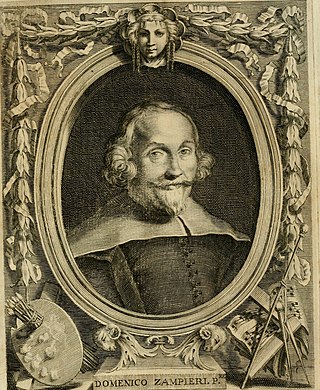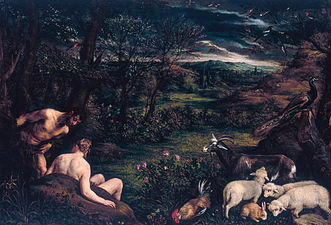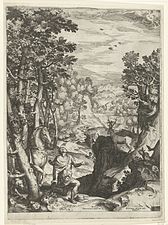
Agostino Carracci was an Italian painter, printmaker, tapestry designer, and art teacher. He was, together with his brother, Annibale Carracci, and cousin, Ludovico Carracci, one of the founders of the Accademia degli Incamminati in Bologna. Intended to devise alternatives to the Mannerist style favored in the preceding decades, this teaching academy helped propel painters of the School of Bologna to prominence.

Annibale Carracci was an Italian painter and instructor, active in Bologna and later in Rome. Along with his brother and cousin, Annibale was one of the progenitors, if not founders of a leading strand of the Baroque style, borrowing from styles from both north and south of their native city, and aspiring for a return to classical monumentality, but adding a more vital dynamism. Painters working under Annibale at the gallery of the Palazzo Farnese would be highly influential in Roman painting for decades.

Palazzo Farnese or Farnese Palace is one of the most important High Renaissance palaces in Rome. Owned by the Italian Republic, it was given to the French government in 1936 for a period of 99 years, and currently serves as the French embassy in Italy.

Domenico Zampieri, known by the diminutive Domenichino after his shortness, was an Italian Baroque painter of the Bolognese School of painters.

Odoardo Farnese was an Italian nobleman, the second son of Alessandro Farnese, Duke of Parma and Maria of Portugal, known for his patronage of the arts. He became a Cardinal of the Roman Catholic Church in 1591, and briefly acted as regent of the Duchy of Parma and Piacenza for his nephew Odoardo from 1622 to 1626.

Jacopo Bassano, known also as Jacopo dal Ponte, was an Italian painter who was born and died in Bassano del Grappa near Venice, and took the village as his surname. Trained in the workshop of his father, Francesco the Elder, and studying under Bonifazio Veronese in Venice, he painted mostly religious paintings including landscape and genre scenes. He often treated biblical themes in the manner of rural genre scenes, portraying people who look like local peasants and depicting animals with real interest. Bassano's pictures were very popular in Venice because of their depiction of animals and nocturnal scenes. His four sons: Francesco Bassano the Younger, Giovanni Battista da Ponte, Leandro Bassano, and Girolamo da Ponte, also became artists and followed him closely in style and subject matter.

Antonio Marziale Carracci was an Italian painter. He was the natural son of Agostino Carracci.

Giovanni Lanfranco was an Italian painter of the Baroque period.

The Loves of the Gods is a monumental fresco cycle, completed by the Bolognese artist Annibale Carracci and his studio, in the Farnese Gallery which is located in the west wing of the Palazzo Farnese, now the French Embassy, in Rome. The frescoes were greatly admired at the time, and were later considered to reflect a significant change in painting style away from sixteenth century Mannerism in anticipation of the development of Baroque and Classicism in Rome during the seventeenth century.

The Choice of Hercules is a painting by the Italian Baroque painter Annibale Carracci. Dating from 1596, it is housed in the Capodimonte Gallery of Naples. The subject is the Choice of Hercules.

Events from the year 1592 in art.

The Carracci were a Bolognese family of artists that played an instrumental role in bringing forth the Baroque style in painting. Brothers Annibale (1560–1609) and Agostino (1557–1602) along with their cousin Ludovico (1555–1619) worked collaboratively. The Carracci family left their legacy in art theory by starting a school for artists in 1582. The school was called the Accademia degli Incamminati, and its main focus was to oppose and challenge Mannerist artistic practices and principles in order to create a renewed art of naturalism and expressive persuasion.

Giovanni Battista Agucchi was an Italian churchman, Papal diplomat and writer on art theory. He was the nephew and brother of cardinals, and might have been one himself if he had lived longer. He served as secretary to the Papal Secretary of State, then the Pope himself, on whose death Agucchi was made a titular bishop and appointed as nuncio to Venice.

Pietà is a c. 1600 oil on canvas painting by Annibale Carracci, the earliest surviving work by him on the subject, which was commissioned by Odoardo Farnese. It moved from Rome to Parma to Naples as part of the Farnese collection and is now in the National Museum of Capodimonte in Naples. It is one of many 16th century Bolognese paintings dedicated to the theme of the Pietà, and it is counted among Carracci's masterpieces.

Christ in Glory with Saints and Odoardo Farnese or 'Christ in Glory with Odoardo Farnese and Saints Peter, John the Evangelist, Mary Magdalene, Hermenegild and Edward is a painting by Annibale Carracci. Placed in the Eremo di Camldoli either early in its life or straight after its creation, at the end of the 17th century Ferdinando II de' Medici moved it to the Galleria Palatina in Florence, where it still hangs.

Christ Crowned with Thorns or Christ Mocked is a 1598–1600 oil on canvas painting by Annibale Carracci, now at the Pinacoteca Nazionale di Bologna.

Venus with a Satyr and Two Cupids or The Bacchante is a 1588-1590 oil on canvas painting by Annibale Carracci, now in the Uffizi in Florence. Its dating is based on its strong Venetian influence - the artist was briefly in the city at the end of the 1580s.

Saint Margaret of Antioch is a 1599 oil on canvas painting by Annibale Carracci, showing Margaret of Antioch. It hangs in Santa Caterina dei Funari church in Rome.

The Mystic Marriage of St Catherine is a c.1585 oil on canvas painting by Annibale Carracci, now in the Gallerie Nazionali di Capodimonte in Naples, Italy. The composition and sfumato effect owe much to Corregio, particularly the latter's painting of the same subject now in the Louvre.

Penitent Magdalene is a c. 1550 oil on canvas painting by Titian, now in the Museo di Capodimonte in Naples.

























